In 2013 it became clear that global growth will remain weak for some time, resulting in downward pressure on cyclical shares. US cyclicals did well relative to defensive shares in 2012 after the QE3 announcement because it was thought that the combination of US stimulus and the ECB's backstop of periphery bonds would spur global growth. Yet cyclical sectors such as natural resources did not significantly benefit from these central bank actions. Defensive shares began to outperform. And after the start of the "taper talk", defensive shares really took off, while cyclicals were held back by sectors such as energy (see post) and homebuilders (see post).
 |
| Cyclical vs. defensive share performance in the US |
But this malaise in cyclical shares is not limited to the US and varies considerably across global equity markets. Credit Suisse looks at the ratio of cyclical to defensive indices by country to determine which equity markets expect to see stronger growth in a particular country and which are likely to slow. Here is the result.
 |
| Source: CS |
Not surprisingly these ratios roughly mirror growth expectations for various countries relative to recent growth (not relative to each other). What's striking here is the dispersion. The markets seem to accept that Abenomics-based stimulus in Japan will pull the nation out of the deflationary spiral and generate growth, albeit a temporary one. Japan's construction companies for example will clearly benefit in the short term from all the extra cash. China however is on the other side of the spectrum (see post), pulling down the overall global growth expectations.
SoberLook.comFrom our sponsor:












